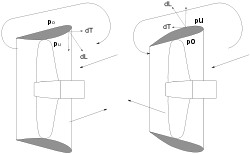
Ducted propeller
Encyclopedia

Propeller
A propeller is a type of fan that transmits power by converting rotational motion into thrust. A pressure difference is produced between the forward and rear surfaces of the airfoil-shaped blade, and a fluid is accelerated behind the blade. Propeller dynamics can be modeled by both Bernoulli's...
fitted with a non-rotating nozzle
Nozzle
A nozzle is a device designed to control the direction or characteristics of a fluid flow as it exits an enclosed chamber or pipe via an orifice....
. It is used to improve the efficiency of the propeller and are especially used on heavily loaded propellers or propellers with limited diameter. It was developed by Luigi Stipa
Luigi Stipa
Luigi Stipa was an Italian aeronautical, hydraulic, and civil engineer and aircraft designer who invented the "intubed propeller" for aircraft, a concept that some aviation historians view as the predecessor of the turbofan engine....
(1931) and Ludwig Kort (1934).
Advantages are increased efficiency, better course stability and less vulnerability to debris. Downsides are reduced efficiency and course stability when sailing astern and increase of cavitation
Cavitation
Cavitation is the formation and then immediate implosion of cavities in a liquidi.e. small liquid-free zones that are the consequence of forces acting upon the liquid...
. Ducted propellers are also used to replace rudder
Rudder
A rudder is a device used to steer a ship, boat, submarine, hovercraft, aircraft or other conveyance that moves through a medium . On an aircraft the rudder is used primarily to counter adverse yaw and p-factor and is not the primary control used to turn the airplane...
s.
Types
There are two types of ducts; accelerating and decelerating. With accelerating ducts, the inflow velocity and efficiency of the propeller is increased. This is the type that is used on heavily loaded propellers or propellers with limited diameter. As Ludwig Kort performed extensive research on this type, it is often called Kort nozzleKort nozzle
The Kort nozzle is a shrouded, ducted propeller assembly for marine propulsion. The hydrodynamic design of the shroud, which is shaped like a foil, offers advantages for certain conditions over bare propellers....
.
With the second type, the inflow velocity is reduced, whereby pressure is increased, reducing cavitation. This is called a pump-jet
Pump-jet
A pump-jet, hydrojet, or water jet, is a marine system that creates a jet of water for propulsion. The mechanical arrangement may be a ducted propeller with nozzle, or a centrifugal pump and nozzle...
, especially in combination with fixed blades or stators.
.svg.png)
NACA airfoil
The NACA airfoils are airfoil shapes for aircraft wings developed by the National Advisory Committee for Aeronautics . The shape of the NACA airfoils is described using a series of digits following the word "NACA." The parameters in the numerical code can be entered into equations to precisely...
s of which the NACA 4415 has very good characteristics. Most commonly used are nozzle 19A and 37 of the MARIN series. Thes have a rounded trailing edge to ease fabrication and increase efficiency sailing astern. Initially, the propellers of the Wageningen B-series were used, later the Kaplan-type with a wider blade tip.
Physics
 |
|
dT = Thrust dL = Lift |
pu: Negative pressure po: Positive pressure |
In a Kort nozzle, the inflow velocity is increased, reducing pressure. This lowers thrust and torque of the propeller. At the same time, a circulation occurs, resulting in an inward aimed force, that has a forward component. The duct therefore has a positive thrust. This is normally larger than the thrust reduction of the propeller. The small clearance between the propeller and duct reduces tip vortex, increasing efficiency.
As drag increases with increasing speed, eventually this will become larger than the added thrust. Vessels that normally operate above this speed are therefore normally not fitted with ducts. When towing, tugboats sail with low speed and heavily loaded propellers, and are often fitted with ducts. Bollard pull
Bollard pull
Bollard pull is a value that allows the comparison of the pulling force of watercraft, particularly tugboats. A mooring bollard may be used as a point of attachment for measuring the force, or pull of the craft.-Background:...
can increase up to 30% with ducts.
With decelerating ducts, the circulation opposite of the Kort nozzle, resulting in a negative thrust of the duct. This type is used for high speed vessels with increased exposure to cavitation and vessels that want to reduce noise levels, such as warships.

